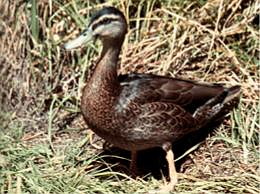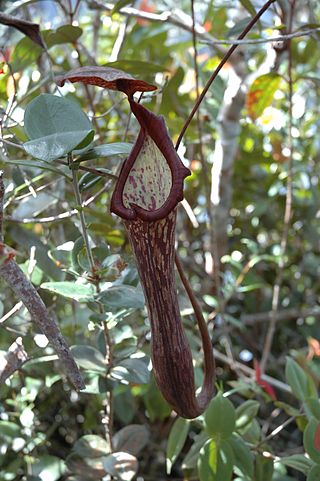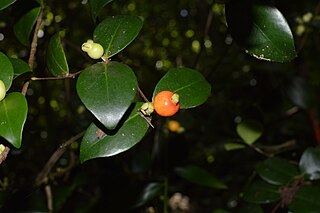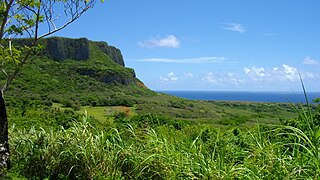
The Mariana Islands, also simply the Marianas, are a crescent-shaped archipelago comprising the summits of fifteen longitudinally oriented, mostly dormant volcanic mountains in the northwestern Pacific Ocean, between the 12th and 21st parallels north and along the 145th meridian east. They lie south-southeast of Japan, west-southwest of Hawaii, north of New Guinea, and east of the Philippines, demarcating the Philippine Sea's eastern limit. They are found in the northern part of the western Oceanic sub-region of Micronesia, and are politically divided into two jurisdictions of the United States: the Commonwealth of the Northern Mariana Islands and, at the southern end of the chain, the territory of Guam. The islands were named after the influential Spanish queen Mariana of Austria following their colonization in the 17th century.

The Mariana mallard or Oustalet's duck is an extinct species of duck of the genus Anas that was endemic to the Mariana Islands. Its taxonomic status is debated, and it has variously been treated as a full species, a subspecies of the mallard or of the Pacific black duck, or sometimes as a subspecies of the Indian spot-billed duck.

The Guam flying fox, also known as the little Marianas fruit bat, is an extinct species of small megabat endemic to Guam in the Marianas Islands in Micronesia that was confirmed extinct due to hunting or habitat changes. It was first recorded in 1931 and was observed roosting with the larger and much more common Mariana fruit bat. The last specimen was a female found roosting at Tarague cliff in March 1967, but it escaped capture. An unconfirmed sighting took place sometime during the 1970s, and no other individuals have been sighted since then.

Nepenthes faizaliana is a tropical pitcher plant endemic to the limestone cliffs of Gunung Mulu National Park in Sarawak, Borneo. It is thought to be most closely related to N. boschiana.

Nepenthes lamii is a tropical pitcher plant endemic to New Guinea, where it grows at an altitude of up to 3520 m above sea level, higher than any other Nepenthes species. Although once confused with N. vieillardii and previously regarded as conspecific with the closely related N. monticola, it is now recognised as a distinct species.

Callicarpa (beautyberry) is a genus of shrubs and small trees in the family Lamiaceae. They are native to east and southeast Asia, Australia, Madagascar, south-eastern North America and South America.

Digitalis davisiana is a species of foxglove, a herbaceous plant in the genus Digitalis in the family Plantaginaceae, formerly in the Scrophulariaceae and briefly the Veronicaceae. It is native to Turkey.

Bikkia tetrandra is an herbaceous member of the family Rubiaceae, distinguished by its white square-shaped flowers. It is native to Papuasia and islands of the western Pacific, including the Caroline Islands, Fiji, Mariana Islands, New Caledonia, New Guinea, Niue, Solomon Islands, Tonga, Vanuatu, and Wallis-Futuna Islands. The stems ignite easily and can be used to make torches or candles.

Eugenia palumbis is a shrub with edible fruits in the family Myrtaceae. It is endemic to the Mariana Islands, including Guam and the Commonwealth of the Northern Mariana Islands.

Gymnosporia thompsonii is a species of plant in the bittersweet family Celastraceae. It is endemic to the Mariana and Caroline Islands, where it grows as a many-stemmed understory shrub or small tree in karst forests. Its wood is used for fuel and its leaves are used medicinally.

Callicarpa candicans is a species of flowering plant in the mint family. It is native Indochina, southern China, Malesia, New Guinea, northern Australia, and Micronesia.

The Marianas tropical dry forests is a tropical and subtropical dry broadleaf forests ecoregion on the Marianas Islands in the western Pacific Ocean.

Syzygium thompsonii is an endemic tree of the Mariana Islands of Guam, Rota, and Saipan with a striking appearance due to its abundance of white flowers and edible fruit that grow directly from the trunk. It is related to the Malay apple but bears smaller tart fruit.

Piper salicinum is a plant in the Piperaceae family that is possibly endemic to the Mariana Islands (Guam), although there is some confusion in the literature as to whether it may have been collected from Mexico and Panama. It has not been observed since its initial collection in 1792.

Rhaphidophora guamensis is a climbing plant in the family Araceae that is endemic to the island of Guam in the Mariana Islands.
Psychotria hombroniana is shrub or tree in the family Rubiaceae that is endemic to the Caroline and Mariana Islands in the northwest Pacific Ocean.

Terminalia rostrata is a large tree found only on the Mariana Island of Asuncion. It is a part of the "Terminalia and ravine forest" on the western and southwestern slopes of the island, consisting of scattered Terminalia rostrata in association with Premna serratifolia, Morinda citrifolia,Hibiscus tiliaceus, and Pandanus tectorius. This forest type is described as the best-developed forest in the Mariana Islands north of Saipan, owing to its protection on the lee side of the mountain. The leaves of Terminalia rostrata are most similar to Terminalia catappa, but they have soft hairs similar to that of Terminalia samoensis. It is otherwise most similar to Terminalia foetidissima, although differing in various ways. The species name refers to the strongly beaked fruit. Fruit bats feed on the husks of the seeds. The species was first discovered by Marjorie V. C. Falanruw during an expedition to the far northern Mariana islands in 1972 and was first described by Francis Raymond Fosberg in the journal Phytologia in 1974.

Hedyotis scabridifolia is an herb or small shrub that is endemic to the volcanic soils of the Mariana Islands of Guam, Rota and Saipan.

Glochidion marianum is a species of plant in the family Phyllanthaceae that is endemic to the islands of Guam and the Caroline Islands.























